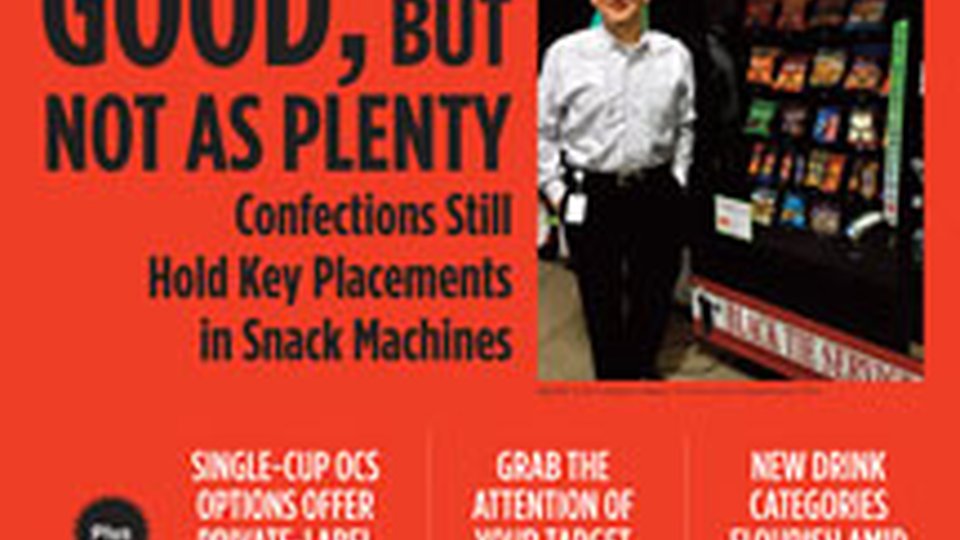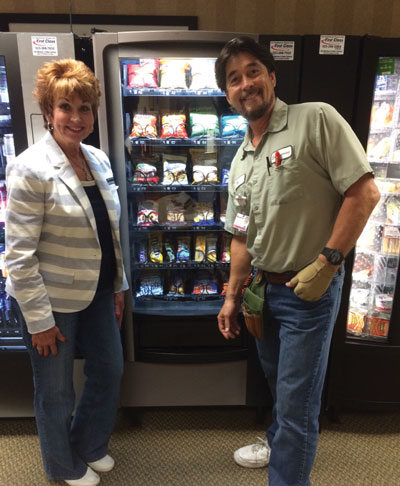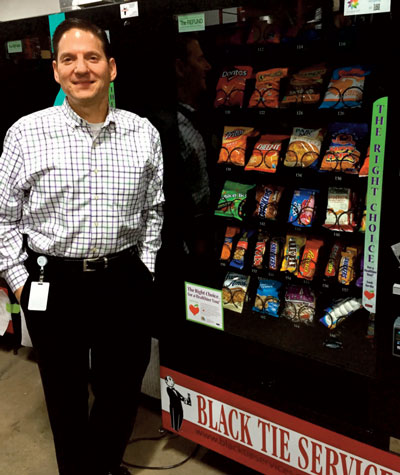News
Market Changes Drive New Sales Approach In Vendings Candy Category

July 27, 2015
TAGS: vending operaor, vending machine, confections, candy, vending, Becky Palazzola, snack vending machine, Snickers, First Class Vending, A Matter of Taste Vending, M&M's, Reese's Peanut Butter Cups, Skittles, Scott Meskin, Black Tie Services, micro market, Steve Marx, Royal Vending, National Automatic Merchandising Association, Fit Pick, Greg Sidwell, G&J Brokerage |
 |
Photo:Becky Palazzola reviews selections in snack machine with Snickers fan Joe Boyd of Sherman Oaks Hospital. |
In the greater Los Angeles market, First Class Vending's Becky Palazzola said she has seen pronounced changes in the candy category in her 25-plus years in the industry. Palazzola and her husband Joe founded A Matter of Taste Vending (Bell Garden, CA) in 1989 and sold the business to First Class Vending in 2012. Becky stayed on as vice-president of client relations.
About 10 years ago, the Palazzolas realized that bagged salty snacks and cookies had greater turns and profit margins than candy. This insight drove them to make a rapid switch from two rows of confections to one. They only ordered new equipment with a single candy tray, and retrofitted machines in the field with a replacement shelf of salty snacks. First Class Vending follows the same approach.
Fewer Facings
"Why waste a second row and the cost of inventory?" Palazzola asked. "A few selections of chocolate meet demand. It doesn't turn like it used to. If people are chocolate eaters and crave it, they will buy one of the top brands, but it's not the go-to afternoon snack for the masses anymore."
Another factor that played into reducing the number of candy facings in machines was A Matter of Taste's growing number of Hispanic customers, who prefer salty and spicy snacks over sweets, in its southern California market.
Around the same time, the vending company's clients began pushing workplace "health" programs in an effort to lower insurance premiums and to satisfy the changing demands of their employees. These have impacted vend choices, and the trend continues.
"Younger, more nutritionally educated customers today look for protein to get them to 5:00. They regard candy as just a quick fix that's followed by a sugar nosedive," Palazzola said. "And baby boomers, whose metabolisms are slowing down, are not quick to reach for a candy bar. We're also in southern California, where people are very body-conscious."
Back To Basics
First Class stocks its four candy mainstays -- Snickers, Peanut M&M's, Reese's Peanut Butter Cups and Skittles -- and rotates in two other top sellers like Twix and Starburst. The other four rows once devoted to sweet treats generally feature better-for-you alternatives like granola and protein bars and nuts.
Palazzola is based in the company's Northridge, CA, office, which serves 17 routes. She said smaller spiral-size candy SKUs are at a minimum, and items like crackers and cookies, once candy alternative mainstays, aren't even in stock -- they have been replaced by healthier choices.
"In many locations, we have only four of the top candy selections," Palazzola said. "As prices have continued to go up, we were driven to reduce another couple of rows. Chocolate in single-serve packages is not what it used to be in the vending industry, and non-chocolate is even less. We've turned more to bagged snacks that pay the bills."
First Class's cost for standard chocolate bars and non-chocolate products, like Skittles and Starburst, is about 61¢, and their vend prices range from $1.10 to $1.35. "We just can't sell it for much less; by the time you include sales tax in California, there's nothing left. You're right there at the slimmest margins."
Palazzola said the majority of First Class clients seek a balanced product mix for their employees, from 25% to 100% "healthy" offerings, which has also contributed to the pronounced reduction in candy facings.
Candy vending has followed the same trajectory for East Coast operator Scott Meskin of Black Tie Services (Halethorpe, MD). His machines carried the longtime standard two shelves with 20 selections of candy and crackers for 20 years, until he saw the segment changing. Like Palazzola, he said the main driver for removing one of the two candy trays in all Black Tie machines was the squeeze that rising wholesale costs were putting on profit margins in core candy items.
Peg Bags Boost Profit
Instead of adding more salty snacks as Palazzola did, he replaced the second shelf with peg bags of candies like Mike and Ike, Swedish Fish and Sour Patch Kids that vend for $2, and completed this update about six years ago in all of Black Tie's machines.
 |
Photo:Scott Meskin, Black Tie Services (Halethorpe, MD) |
Equally significant is that Black Tie's sixth-biggest seller in the smaller "candy" spirals is cheese and peanut butter crackers, because their cost is only 19¢ a unit.
"Normally I'd say if it's not one of our best sellers, maybe take it out," he commented. "But the profit of the crackers exceeds Twix and Reese's, despite the lower turns. When my cost is 60¢ for a candy bar and 19¢ for crackers, and both sell for $1.25, it makes sense to keep the crackers."
He's now considering eliminating four more traditional candy items, splitting the shelf and replacing them with two higher-priced peg bags. Black Tie's cost is 85¢ to 90¢ for a peg bag that will vend for $2.
"With cost of goods about 40% to 42%, it's tough to pay 60¢ or 62¢ and sell it for $1.25," he said. "That's not enough margin, when you figure in sales tax, commissions and all other costs. I'd rather make a dollar a vend for a peg bag instead of fighting to make 60¢ a vend per candy bar. We've broken the ceiling with credit cards so that we can even sell the bigger bags for $2.50 and $3 in some places."
More For The Money
Customers also perceive the value of getting a 5-oz. bag for $2, compared to a 1.75-oz. candy bar for $1.25. "Chocolate is getting smaller and smaller and customers know it's shrinking," the Maryland operator observed. "What was once a 2.5-oz. Snickers bar is now 1.8 oz. In a few years, it will be four peanuts in a wrapper and we'll call it Snickers. The value is not there and it's hurting the category."
Meskin also has noticed that his customers are becoming more health conscious, and so they are moving away from conventional candy. They're conditioned to paying $2.50 to $3 for alternatives like protein bars in c-stores, and this makes them more apt to do the same at his machines, especially since they can pay with a credit or debit card.
Black Tie is a member of the Greensboro, NC-based US Connect vending operator network and features its The Right Choice program. Healthier selections are merchandised from top to bottom on the right-hand side of every machine, including Nature Valley granola and Nutri-Grain cereal bars, Planter's peanuts and low-fat Snackwell's.
Health Focus
The vending operation also has created a dedicated "healthy"-branded combo machine with snacks on top and beverages on the bottom that it places in some locations alongside conventional snack and drink machines in a bank. All of the better-for-you products in the dedicated healthy machines are from PepsiCo, ranging from its Tropicana juice and Izze natural soda, Sabra hummus and Gatorade protein bars to whole-grain Quaker cookies and newer Real Medleys fruit and nut bars.
Meskin said he has been amazed at the results and that the response to the all-healthy approach has changed his outlook, and his strategy, as he moves forward forward.
"I always thought healthy vending was a necessary evil. Now I see it as all new business, and I may need to revisit accounts where sales are down," the operator said. "At first, we added the 'all-healthy' machines next to regular ones to keep HR happy. Now we're doubling sales by installing them at some locations." Sales from the "healthy" machines have proven to be incremental, Meskin said, with volume at the traditional venders remaining steady.
He has found that the machines are attracting a whole new clientele that previously left the office to find what they wanted at the local c-store or Starbucks. "The 60-year-olds who retired are being replaced by 30-year-olds who don't eat out of a vending machine," he commented. "People who were looking for 'healthy' didn't come before. Now they know this is their machine. But it is only a fit at the right locations."
Sweet Micromarket Sales
Candy trends in Black Tie's micromarkets differ significantly from its vending. For one thing, prices are higher; a candy bar that would vend for $1.25 costs $1.29 plus tax in a micromarket. Consumers' top choices are also different and more wide-ranging because of the ease of making a bigger variety of options available to them.
Meskin recalled that when Black Tie installed its first market five years ago, it started by merchandising a box of Snickers and Peanut M&M's, expecting them to fly off the shelf. But they did not sell nearly as quickly nor represent nearly the same percentage of total sales as they would in a vending machine. Meskin said he has found that micromarket customers, with more diversified options from which to choose, tend to favor peg bags of candies like bite-size Snickers and Twix and trail and nut mixes that cost as much as $3.99 a bag.
Midwestern operator Steve Marx of Royal Vending (Maple Grove, MN) said he recognized many years ago that space to sales were off in the candy category and, like Palazzola and Meskin, reduced his small spiral facings from 20 to 10.
"Price was a big motivator, with the cost of candy going up, and there's more innovation in salty and cookies and pastries than in candy," he said "It just made sense if we could sell both chips and candy for $1, to sell more chips. There's a significant difference in wholesale cost."
With costs pushing candy pricing to $1.10 and higher, Marx said concern over lost turns and customers is similar to the challenge the industry faced more than a decade ago with the price resistance that accompanied the move to 20-fl.oz. soda. Many soda customers began to recognize the value of paying more than $1 for the larger portion. But with candy, they're reaching into their pockets for more change for the same product, or one that's smaller in many cases.
For that reason, Marx is beginning to move some of his candy selections to a larger bite-size pack that vends for $2, perceived as having higher value. Healthier products in the smaller coils are also satisfying contemporary demands on his routes.
Cashless Advantage
"It's easier today than it was years ago," Marx said. "Most machines are equipped with credit-card readers, so price is not as important to consumers if they recognize value. I can't believe how fast I've seen bags of Mike & Ike fly off the shelf in some places. A lot of smaller guys are out of business because they don't have credit card readers."
Marx said his company was one of the first in his market to raise prices above $1, adding that he has not encountered resistance for products perceived as being more wholesome.
"Health-conscious people have the knowledge to understand that healthier items have a higher cost than a candy bar," he said. "They're also better planners and will bring something to work if they don't frequent the vending machine and know it's an option there. It's very important today to make products available with nutritional value that don't taste like cardboard and at the same time make decent margins."
Royal Vending ensures a balanced mix by merchandising at least eight products that meet the National Automatic Merchandising Association's Fit Pick nutritional guidelines in every machine.
Longtime vending broker Greg Sidwell of G&J Brokerage (Palm Harbor, FL) said that operators replacing standard candy bars with premium bite-size candy that vends between $2 and $2.50 is a trend he sees taking hold nationwide.
"It's a result of operators' desire to go cashless and support higher price points, the higher cost of goods and an effort to get overall cashflow up," Sidwell said. "Many may have five or six standard candy selections, with other premium products filling out the shelf to get the price point up. And customers gravitate toward the bite-size bags and healthier and more upscale offerings; it's what they want."
Micromarkets have allowed operators to provide a much bigger selection of higher-priced premium candy in larger bags, which has opened up a wider range of prices, Sidwell added.
Sidwell noted that while the focus the government has put on health awareness gained steady momentum over the past two decades, more recently there's been immense pressure put upon vending operators' clients by their health insurance providers to foster employee health and wellness. And operators are adapting machine menus to support that movement.
"Many HR directors' bonuses are predicated by overall company health," said Sidwell. "They want to get blood pressure, sugar and cholesterol down, but they want better-for-you products that taste good, that their people will actually eat."
The good news, he says, is that manufacturers have risen to the occasion, and that consumers are used to seeking out and paying more for healthy choices they enjoy in vending because they are in widespread retail distribution.
The 30-year vend product veteran expressed one caveat regarding all the excitement around the growing "healthy" segment and the opportunity it presents operators. It's that the main sales drivers in vending remain the tried-and-true candy and salty snack standbys, and Sidwell expects that it will remain that way.
"It's similar to all the studies showing how fast water is growing, but it's growing so fast because it's so small a segment. The real driver in vending in most cases is still soda, and it's the same with candy and traditional snacks," Sidwell noted. "Other categories are growing and catching on in the snack vending machine and replacing some candy and traditional snack selections, but maybe will they represent 15% of sales? Maybe 20%? There's still a lot of value that core candy brings, and I think it will always hold the key spot in machines."


